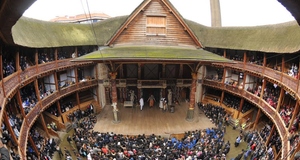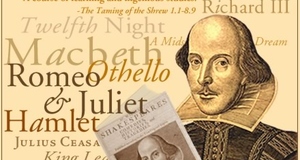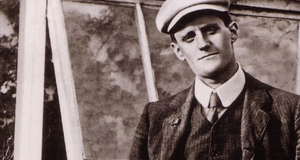Baz Luhrmann's "Romeo + Juliet" compared with Shakespeare's Original Work
By
2010, Vol. 2 No. 04 | pg. 1/1
KEYWORDS:
Baz Luhrmann’s kaleidoscopic film adaptation of Romeo and Juliet, while often leaving much to be desired from the two main actors in the way of delivery, presents a fascinating modern interpretation of the 16th century drama. David Ansen, film critic, describes it as “alternately enrapturing and exhausting, brilliant and glib…a "Romeo and Juliet" more for the eyes than the ears” (Newsweek). Sir Philip Sidney states in his Apology for Poetry that poetry should both delight and teach, and both the text and the film serve this purpose well—each suited to the time in which they were presented. Shakespeare incorporated jokes of the time, mentions of royalty, and allusions to historical events in his plays. Luhrmann does this as well, pulling in numerous references to recent pop culture. Both Shakespeare and Luhrmann endeavored to delight their audiences with beautiful costumes and familiar music, and to teach them with the basic moral precepts inherent in the story. A mere glance at the film will show anyone with even the slightest knowledge of the play that the two are ferociously different in terms of setting, costume, casting, music, and props. A closer reading, however, will also illuminate significant deviations in verse. The differences between these two works are distinctly illustrated in Act One, Scene One of the text and its matching film scene. Here Shakespeare's text shows Samson and Gregory of the house of Capulet exchanging in witty banter: SAMSON: I strike quickly, being moved. They continue their repartee until Abraham and another servingman of the Montagues arrive. Gregory advises, “Draw thy tool. Here comes of the house of Montagues” (1.1 29). Samson responds, “Quarrel, I will back thee” (1.1 30). Gregory suggests that frowning in their general direction will suffice initially. Samson disagrees: SAMSON: Nay, as they dare. I will bite my thumb at them, which is a disgrace to them if they bear it. They proceed to argue about whose master is better, and fight until Benvolio arrives and tells them to put up their swords. Tybalt shows up and further provokes the fight. Curiously enough, the corresponding scene from the film shows instead Benvolio and the “Montague boys” cruising along the freeway in a bright yellow convertible, laughing raucously, with one of them turning around to face the camera and yelling: “A dog of the house of Capulet moves me!” They pull up to a gas station, Benvolio goes inside, and immediately afterward arrive Tybalt and the “Capulet boys,” Abraham (here abbreviated to Abra) and another. Tybalt goes inside, but Abra remains next to the car, sees the Montague boys, and faces them with an intimidating glare. The Montague boys quake with fear, and jump when Abra yells, “Boo!” Abra, of course, laughs hysterically and gets back into his car; ready to drive away until he sees one of the Montague boys bite his thumb. The ensuing fight scene provides an excellent example of the difference in choreography and props. In the text, the characters all fight with swords, on a stage empty of all but citizens of the watch. In the ultra-modernized film, the characters are all possessed of pistols bearing the name of their respective houses, and they make use of the surrounding cars, film extras, and various architectural trappings of the gas station where the fight is staged. Interestingly enough, though, when Benvolio entreats the Capulets and his fellow Montagues to lower their weapons, the wording does not exchange swords for guns, but remains as it reads in the original text (1.1 57). The film’s setting is a cunning twist on the original: instead of Verona, Italy, events take place in a teeming seaside metropolis called Verona Beach (bearing a striking resemblance to modern day Miami) that has been ravaged by the ongoing feud between Capulet and Montague. Verona Beach is a modern-day city, with cars, high-rise buildings, gas stations, and hot dogs stands, none of which were even conceived (or much less, available) during the time that Romeo and Juliet was written or performed. Luhrmann’s costumes are also highly modernized. This opening scene finds the Montague boys parading around in Hawaiian shirts and sporting unnaturally colored hair, while the Capulet boys favor leather and metal-heeled boots. These are some drastic changes from the traditional Elizabethan wear of the time. In addition, the film makes no pretense at any English or Italian (to fit the original setting) accent from its characters. Luhrmann explains that this is because he considers the American language as better attuned to Shakespearian text: "When Shakespeare wrote these plays, they were written for an accent that was much more like an American sound, and when you do Shakespeare with an American accent it makes the language very strong, very alive” (Weinraub). Musically in this act, the audience is provided with modern hip-hop, electric guitar sound effects, a nod to musical themes from spaghetti Western showdowns, and a chorus chanting a direct Latin translation of the play’s prologue. Luhrmann explains in an interview on the Music Edition of Romeo + Juliet that Shakespeare used all varieties of music to reach the highly varied audience in the Globe Theater: church music, folk music, and popular music of the times. Luhrmann echoes this in his version of the drama. Sidney explains that poetry is the most effective means of instruction, as poetry can “teach…not only by delivering forth his very being, his causes and effects, but also by making known his enemy, vice, which must be destroyed, and his cumbersome servant, passion, which much be mastered” (Duncan-Jones 220). Luhrmann takes Shakespeare’s task of instructing the masses against the folly of absurd family feuds and artfully updates it for the 20th century, retaining its essential moral argument while making it something to which modern audiences can more easily relate. ReferencesAnsen, David. "It's the '90s, So the Bard Is Back.” Newsweek 4 Nov. 1996: 73. Duncan-Jones, Katherine, ed. Sir Philip Sidney: A Critical Edition of the Major Works. New York: Oxford UP, 1989. Romeo + Juliet. Dir. Baz Luhrmann. Perf. Leonardo DiCaprio and Claire Danes. DVD. Twentieth-Century Fox, 1996. Shakespeare, William. The Norton Shakespeare, Based on the Oxford Edition, Second Edition One-Volume Hardcover. New York: W. W. Norton, 2008. Weinraub, Bernard. "Audiences In Love With the Doomed Lovers.” New York Times 5 Nov. 1996, Late ed., sec. C.
Suggested Reading from Inquiries Journal
Inquiries Journal provides undergraduate and graduate students around the world a platform for the wide dissemination of academic work over a range of core disciplines. Representing the work of students from hundreds of institutions around the globe, Inquiries Journal's large database of academic articles is completely free. Learn more | Blog | Submit Latest in Literature |
















